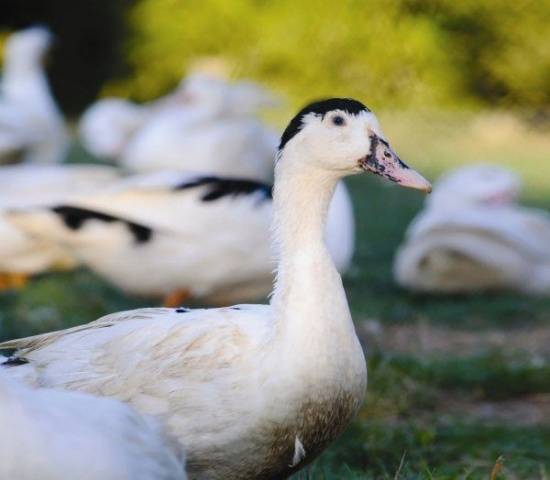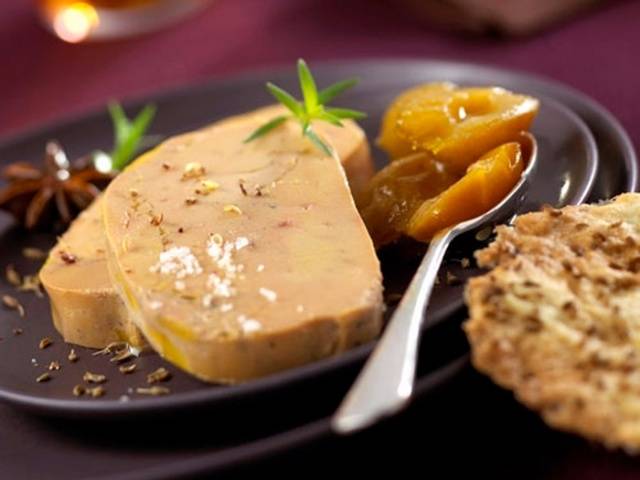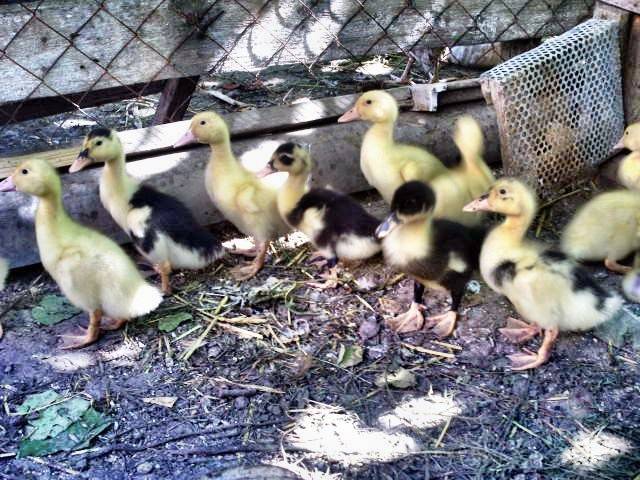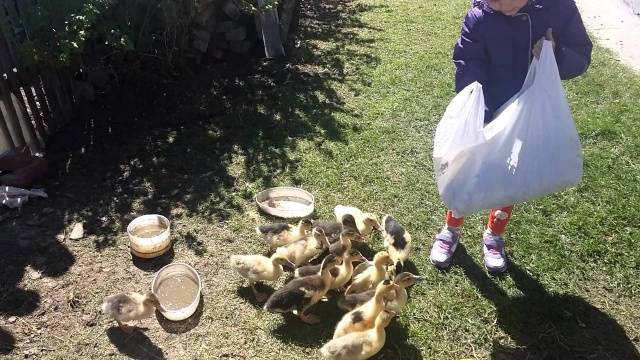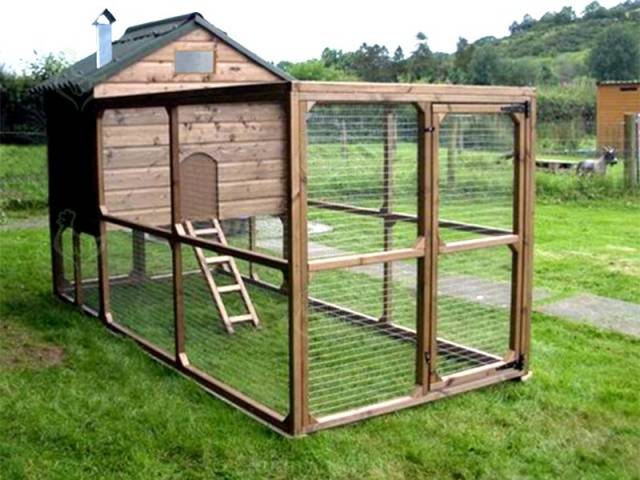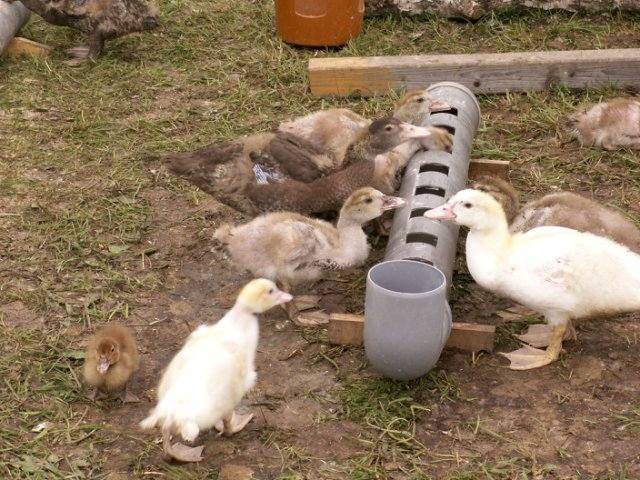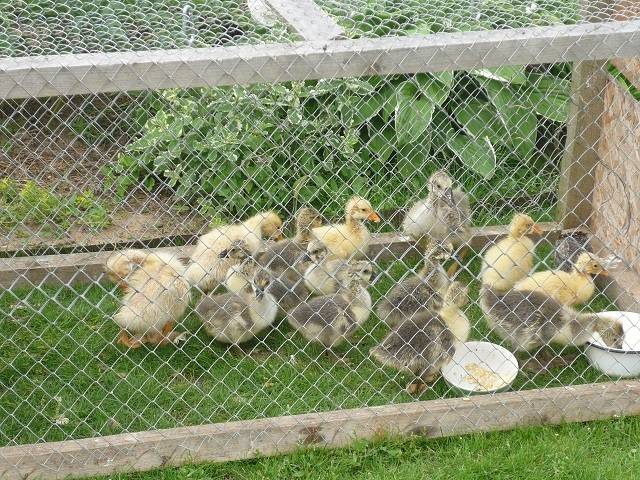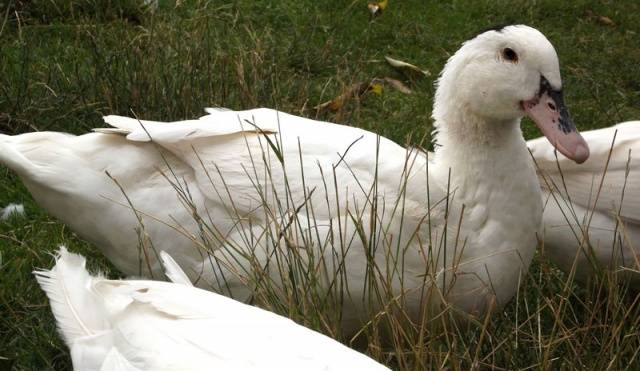Content
Household poultry farming is becoming increasingly common among farmers. First of all, because the meat of their birds is guaranteed to be safe and fresh. Mularda ducks are great for breeding at home. They are also called "meat ducks".
The origin of mulard ducks and their description
Mularda ducks are hybrids bred by French breeders by crossing musk and Peking duck breeds. There are options for crossing with breeds: Orpington, Rouen and white alier. The result is a duck with a calm character, with meat of excellent taste and rapidly gaining weight.
The plumage of mulard ducks is white; there is a dark spot on the head, which is a distinctive feature of this hybrid.
Look at the photo of the domestic duck mulard
Mularda ducks belong to broilers, i.e. bred for meat production. Mulard ducks are great for home breeding, as well as for growing on an industrial scale. The weight of adult females is up to 6.5 kg, of males - up to 7 kg. Ducklings are distinguished by a good rate of weight gain: in two months they weigh up to 1.5 kg.
For a description of the maturation of mulard ducks, see the video:
Features of a hybrid of mulard ducks
As with any poultry, mulard ducks have positive and negative qualities.
Advantages of mulard ducks hybrid
- Undemanding to conditions of detention... Domestic mulard ducks are absolutely not whimsical to content and can adapt to any conditions, including temperature extremes, which is an undoubted plus for Russian breeders.
- Unpretentious feeding... Ducks of the Mulard breed are undemanding to food and do not overeat. However, it is worth remembering that quality feeding leads to greater bird productivity. Due to its large size, softness and nutritional value, mulard duck liver is considered the best for foie gras production. The male's liver can weigh up to 550 grams.
- Good immunity... An important quality is the presence of a very strong immune system in ducks: mulards are extremely rare.
- Fast maturity... Mulard ducks reach the slaughter weight already at 3-4 months, provided they are provided with high-quality feed. Due to this early maturity, duck meat turns out to be especially tender and tasty.
- Excellent quality characteristics of meat... The low percentage of fat in mulard duck meat is comparable to that of goose - only 3%. At the same time, it takes more than six months to fatten a goose, and mulards reach slaughter age from three months. For the excellent taste of mulard duck meat, one should thank the musky breed, on the basis of which the hybrid was bred.
- Cleanliness... Mulard ducks are neat. The importance of this quality is fundamental to farmers who breed ducks for sale and use their feathers and down.
- Calm character... Domestic mulard ducks do not bother the owners with screams and quarrels.
Disadvantages of mulard ducks
Mularda ducks cannot reproduce offspring: all female eggs are unfertilized. Therefore, in order to continue raising mulard ducks, it is necessary to constantly buy additional ducklings. Some farmers try to breed domestic mulard ducks on their own by buying and crossing musky ducks with Peking ducks.However, it should be understood that the result can be very unpredictable and the qualitative characteristics of mulard ducks may not be fully expressed.
Caring for mulard ducklings
It is desirable to raise ducklings separately with other birds, then they will better feed and grow.
Due to the fact that ducks are waterfowl, care should be taken to have a natural habitat for them. It is great if there is a pond near the place where the ducks are walking. If it is not there, you can make an artificial one.
Ducklings need light around the clock, which allows them to adapt to their environment as quickly as possible. As the chicks grow, the lighting can be left on for 15-17 hours.
To prevent the death of newborn mulard ducklings from hypothermia, it is necessary to maintain the night temperature at a level not lower than +28 degrees, the daytime temperature at least 23 degrees.
Straw or hay should be used as bedding for mulard ducklings. Sawdust is not suitable for this purpose, because they absorb moisture well and dry for a long time - if the duck is constantly on a damp surface, it can catch cold and die.
Organization of meals for mulard ducks
At first, mulard ducklings are given boiled porridge mixed with a boiled egg for eating. The porridge should be thin enough to provide moisture to the ducklings. Over time, greens are added to the mash, which should be chopped very finely. Greens provide mulard ducklings with essential vitamins and fiber. However, it should be remembered that the digestive system of the ducklings is still quite weak, so do not overuse the amount of green supplement.
Starting from the eighth day of life of ducklings, boiled potatoes are introduced into their diet. Gradually, mineral supplements should be introduced, such as: ground egg shell, shell or chalk. Minerals are essential for the growth and health of ducklings.
Types of food for domestic ducks mulard
- Cereals: barley, legumes, wheat, corn, oats. Due to the high content of carbohydrates in grains, mulard ducks quickly gain weight. Such food is well absorbed by mulard.
- Waste from recycled raw materials: meal and cake (sunflower, soybeans, peanuts, cotton, rapeseed, beet), yeast, bran, bard.
- Juicy feed: aquatic vegetation (elodea, duckweed, pond), greens (nettles, alfalfa, clover, peas), combined silage (fermented grass with vegetables), vegetables (carrots, pumpkin, cabbage).
- Animal feed: ideally insects, worms, fry, frogs. At home: meat and bone and fish meal, small fish, dairy products.
In the warm season, if domestic mulard ducks are not free grazing near a natural reservoir, they should be fed four times a day: twice with dry food and two with wet mash. Aquatic vegetation should be added to wet food. If the ducks are released to the reservoir and pasture, it is enough to give them food twice a day.
In winter, ducks are fed twice a day: once with combined silage and a wet mash, the second with dry food. Be sure to add steamed hay, fish or meat and bone meal, boiled potatoes and dust.
Conditions for keeping mulard ducks
Despite the fact that mulard ducks are completely unpretentious to the conditions of detention, it is still worth equipping the poultry house in such a way that the ducks are as comfortable as possible in it. As a result of the correct approach to keeping, mularda ducks will quickly reach the productivity declared for this hybrid.
Poultry house
Wood is considered the ideal material for a poultry house. The best place to build will be the south side on some elevation, or you can raise the house above the ground by at least half a meter (see photo).
House size is calculated from one square meter per three ducks.Mulards do not need perches, they spend all the time downstairs, so the floor must be covered (in summer, bedding is almost unnecessary, in winter it will need about 6 kg per individual).
The house should be warm and dry - humidity has a bad effect on the plumage of ducks, the cover becomes less dense and there is a risk of mulard disease.
If the entrance to the house is too high for the ducks, a ramp or ladder should be attached to the entrance at a slope that will allow the mulards to climb unhindered.
For a description of the poultry house from the greenhouse for the wintering of mulard ducks, see the video
Feeders
The feeders should be at the height of the back of the mulard ducks. Each type of food should have its own feeder: for wet mash, mineral and vitamin supplements, dry food, herbs. An important condition when choosing a feeder is the convenience of its washing and disinfection.
Feeders can be either simple (for example, from auxiliary materials), or automatic, feed into which is fed in descending order without the participation of the farmer.
Drinking bowls
Mulard ducks must always have fresh and clean drinking water in the access zone. It is better if a drip trough is organized for the watering place, since the mulard have a short intestine and a large volume of water consumed quickly removes food from the body. The possibility of drinking from a natural reservoir, which contains duckweed, has a very favorable effect on the development of mulard ducks.
Nest
Despite the fact that mulard ducks are bred for meat, females still lay eggs. Therefore, it will be necessary to install nests in the poultry house, which are also necessary if the purchased eggs of mulard ducks are hatched by an adult female of the hybrid.
To install the nest, choose the quietest and most secluded area in the house, where the least amount of light falls. It is advisable to position the structure so that the ducks turn out to be with their beak against the wall, due to this, the effect of privacy will be enhanced. One nest should be designed for one female.
At the bottom of the nest, you need to put bedding in such an amount that the eggs cannot get damaged. To prevent the loss of eggs, the nest must be provided with bumpers.
Walking
Since the mulard hybrid ducks are not prone to obesity, they do not need an hour-long walks in a large area. The most optimal for them is free range near the reservoir. If there are no opportunities for organizing such a walk, a small courtyard can be allocated for walking. The minimum number of square meters per duck is one.
For walking ducklings in the yard, you can make a corral from a frame, sheathed on all sides, except for the bottom, with a metal mesh. The design will protect the ducklings from other birds or animals and prevent the chicks from scattering. The positive aspect of such a corral is its mobility: when the ducklings have eaten all the grass under the structure, it can be moved to another area. Drinking water and feed must be placed inside the pen. Look at the photo how the corral looks like.
Reviews of mulard duck breeders
Most farmers have positive reviews about the breeding of mulard ducks at home. Breeders note their fast growth, lean, tasty meat. Many ducks feed the ducks with a mixture of chicken and pork feed and notice that mulardy ducks eat a lot until the age of three months, then the appetite becomes moderate. Breeders advise to remove the poultry for meat with the onset of winter cold so that there are no problems with the storage of products.
Of the minuses, the absence of offspring and the fearfulness of mulard ducks are distinguished. A large number of farmers fell for the bait of unscrupulous mulard duck sellers, who claimed that the females of this hybrid are distinguished by high egg production. Breeders bought mulard ducks in order to reproduce offspring and were disappointed when they were not received. In this regard, their reviews of mulard ducks are negative.
Conclusion
Ducks of the mulard hybrid are great for breeding at home: simplicity in keeping and eating, good health and fast growth allow even beginners to raise ducks.
